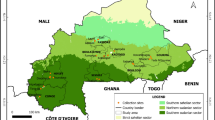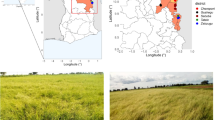Abstract
The changes of genetic diversity over time were monitored in 504 European barley cultivars released during the 20th century by genotyping with 35 genomic microsatellites. For analysis, the following four temporal groups were distinguished: 1900–1929 (TG1 with 19 cultivars), 1930–1949 (TG2 with 40 cultivars), 1950–1979 (237 cultivars as TG3), and 1980–2000 (TG4 consisting of 208 cultivars). After rarefaction of allelic diversity data to the comparable sample size of 18 varieties, of the 159 alleles found in the first group (TG1) 134 were retained in the last group (TG4) resulting in a loss of only 15.7% of alleles. On the other hand 51 novel alleles were discovered in the group representing the last investigated time period (TG4) in comparison with the TG1. Novel alleles appeared evenly distributed over the genome, almost at all investigated genomic loci, with up to five such novel alleles per locus. Alleles specific for a temporal group were discovered for all investigated time periods, however analysis of molecular variance (AMOVA) did not reveal any significant population structure attributable to temporal decadal grouping. Only 2.77% of the total observed variance was due to differences between the four temporal groups and 1.42% between individual decades of the same temporal group, while 95.81% of the variance was due to variation within temporal groups. The distinction between two-rowed and six-rowed genetic types accounted for 19.5% of the total observed variance by AMOVA, whereas the comparison between ‘winter’ and ‘spring’ types accounted for 17% of the total observed variation. The analysis of linkage disequilibrium did not reveal statistically significant differences between the temporal groups. The results indicated that the impact of breeding effort and variety delivery systems did not result in any significant quantitative losses of genetic diversity in the representative set of barley cultivars over the four time periods.




Similar content being viewed by others
References
Christiansen MJ, Andersen SB, Ortiz R (2002) Diversity changes in an intensively bred wheat germplasm during the 20th century. Mol Breed 9:1–11
Donini P, Law JR, Koebner RMD, Reeves JC, Cooke RJ (2000) Temporal trends in the diversity of UK wheat. Theor Appl Genet 100:912–917
Fu Y-B, Peterson GW, Richards KW, Somers D, DePauw RM, Clarke JM (2005) Allelic reduction and genetic shift in the Canadian hard red spring wheat germplasm released from 1845 to 2004. Theor Appl Genet 110:1505–1516
Fu Y-B, Peterson GW, Yu Ju-K, Gao L, Jia J, Richards KW (2006) Impact of plant breeding on genetic diversity of the Canadian hard red spring wheat germplasm as revealed by EST-derived SSR markers. Theor Appl Genet 112:1239–1247
Fu Y-B (2006) Impact of plant breeding on genetic diversity of agricultural crops: searching for molecular evidence. Plant Genet Res 4:71–78
Glemin S, Gaude T, Guillemin M-L, Lourmas M, Olivieri I, Mignot A (2005) Balancing selection in the wild: testing population genetics theory of self-incompatibility in the rare species Brassica insularis. Genetics 171:279–289
Hinds DA, Stuve LL, Nilsen GB, Halperin E, Eskin E, Ballinger DG, Frazer KA, Cox DR (2005) Whole-genome patterns of common DNA variation in three human populations. Science 307:1072–1079
Huang XQ, Wolf M, Ganal MW, Orford S, Koebner RMD, Röder MS (2007) Did modern plant breeding lead to genetic erosion in European winter wheat varieties? Crop Sci 47:343–349
Khlestkina EK, Huang XQ, Quenum FJB, Chebotar S, Röder MS, Börner A (2004) Genetic diversity in cultivated plants-loss or stability. Theor Appl Genet 108:1466–1472
Khlestkina EK, Varshney RK, Röder MS, Graner A, Börner A (2006) A comparative assessment of genetic diversity in cultivated barley collected in different decades of the last century in Austria, Albania and India by using genomic and genic SSR markers. Plant Genet Resour 4:125–133
Koebner RM, Donini P, Reeves JC, Cooke RJ, Law JR (2003) Temporal flux in the morphological and molecular diversity of UK barley. Theor Appl Genet 106:550–558
Kraakman ATW, Niks RE, Van der Berg PM, Stam P, Van Eeuwijk FA (2004) Linkage disequilibrium mapping of yield and yield stability in modern spring barley cultivars. Genetics 168:435–446
Le Clerc V, Cadot V, Canadas M, Lallemand J, Guerin D, Boulineau F (2006) Indicators to assess temporal genetic diversity in the French catalogue: no losses for maize and peas. Theor Appl Genet 113:1197–1209
Li Y, Röder MS, Fahima T, Kirzhner V, Beiles A, Korol AB, Nevo A (2000) Natural selection causing microsatellite divergence wild emmer wheat at the ecologically variable microsite at Ammiad, Israel. Theor Appl Genet 100:985–999
Li JZ, Sjakste TG, Röder MS, Ganal MW (2003) Development and genetic mapping of 127 new microsatellite markers in barley. Theor Appl Genet 107:1021–1027
Liu ZW, Biyashev RM, Saghai Maroof MA (1996) Development of simple sequence repeat DNA markers and their integration into a barley linkage map. Theor Appl Genet 93:869–876
Lu H, Bernardo R (2001) Molecular marker diversity among current and historical maize inbreds. Theor Appl Genet 103:613–617
Maccaferri M, Sanguineti MC, Noli E, Tuberosa R (2005) Population structure and long-range linkage disequilibrium in a durum wheat elite collection. Mol Breed 15:271–289
Malysheva-Otto LV, Ganal MW, Röder MS (2006) Analysis of molecular diversity, population structure and linkage disequilibrium in a worldwide survey of cultivated barley germplasm (Hordeum vulgare L.). BMC Genet 7:6
Nei M (1973) Analysis of gene diversity in subdivided populations. Proc Natl Acad Sci USA 70:3321–3323
Nei M, Li WH (1979) Mathematical model for studying genetic variation in terms of restriction endonucleases. Proc Natl Acad Sci USA 76:5269–5273
Ordon F, Ahlemeyer J, Werner K, Köhler W, Friedt W (2005) Molecular assessment of genetic diversity in winter barley and its use in breeding. Euphytica 146:21–28
Petit RJ, Mousadik AE, Pons O (1998) Identifying populations for conservation on the basis of genetic markers. Conserv Biol 12:844–855
Ramsay L, Macaulay M, Ivanissevich degli S, MacLean K, Cardle L, Fuller J, Edwards KJ, Tuvesson S, Morgante M, Massari A, Maestri E, Marmiroli N, Sjakste T, Ganal M, Powell W, Waugh R (2000) A simple sequence repeat-based linkage map of barley. Genetics 156:1997–2005
Reeves JC, Chiapparino E, Donini P, Ganal M, Guiard J, Hamrit S, Heckenberger M, Huan XQ, Van Kaauwen M, Kochieva E, Koebner R, Law JR, Lea V, LeClerc V, Van der Lee T, Leigh F, Van der Linden G, Malysheva L, Melchinger AE, Orford S, Reif JC, Röder M, Schulman A, Vosman B, Van der Wiel C, Wolf M, Zhang D (2004) Changes over time in the genetic diversity of four major European crops: a report from the Gediflux Framework 5 project. Proceedings of the XVIIth EUCARPIA General Congress, Tulln, Austria, 8–11 September 2004, 3–7
Reif JC, Hamrit S, Heckenberger M, Schipprack W, Maurer HP, Bohn M, Melchinger AE (2005a) Trends in genetic diversity among European maize cultivars and their parental components during the past 50 years. Theor Appl Genet 111:838–845
Reif JC, Zhang P, Dreisigacker S, Warburton ML, van Ginkel M, Hoisington D, Bohn M, Melchinger AE (2005b) Wheat genetic diversity trends during domestication and breeding. Theor Appl Genet 110:859–864
Röder MS, Korzun V, Wendehake K, Plaschke J, Tixier MH, Leroy P, Ganal MW (1998) A microsatellite map of wheat. Genetics 149:2007–2023
Röder MS, Wendehake K, Korzun V, Bredemeijer G, Laborie D, Bertrand L, Isaac P, Rendell S, Jackson J, Vosman B, Ganal MW (2002) Construction and analysis of a microsatellite-based database of European wheat varieties. Theor Appl Genet 106:67–73
Rohlf FJ (1998) NTSYS-pc: numerical taxonomy and multivariate analysis system. Applied Biostatistics Inc., New York
Roussel V, Leisova L, Exbrayat F, Stehno Z, Balfourier F (2005) SSR allelic diversity changes in 480 European bread wheat varieties released from 1840 to 2000. Theor Appl Genet 111:162–170
Roussel V, Koenig J, Beckert M, Balfourier F (2004) Molecular diversity in French bread wheat accessions related to temporal trends and breeder origin. Theor Appl Genet 108:920–930
Russell JR, Ellis RP, Thomas WTB, Waugh R, Provan J, Booth A, Fuller J, Lawrence P, Young G, Powell W (2000) A retrospective analysis of spring barley germplasm development from ‘foundation genotypes’ to currently successful cultivars. Mol Breed 6:553–568
Schneider S, Roessli D, Excoffier L (2002) Arlequin ver 2.001: a software for population genetics data analysis. Genetics and Biometry Laboratory, University of Geneva, Switzerland (available at http://lgb.unige.ch/arlequin/software)
Soleimani VD, Baum BR, Johnson DA (2005) Genetic diversity among barley cultivars assessed by sequence-specific amplification polymorphism. Theor Appl Genet 110:1290–1300
Struss D, Plieske J (1998) The use of microsatellite markers for detection of genetic diversity in barley populations. Theor Appl Genet 97:308–315
Tanksley SD, McCouch SR (1997) Seed banks and molecular maps: unlocking genetic potential from the wild. Science 277:1063–1066
Yeh FC, Yang RC, Boyle T, Ye ZH, Mao JX (1997) POPGENE, the user-friendly shareware for population genetic analysis. Molecular Biology and Biotechnology Center, University of Alberta, Canada
Acknowledgement
We thank Ellen Weiß and Sylvia Vetter for excellent technical assistance and Elena Chiapparino for providing partly the DNA and milled flour of each barley variety as well as variety information. We thank Paolo Donini for useful discussions. This work was conducted within the framework of the project ‘GEDIFLUX’ (contract No. QLK5-CT-2001-00934) supported by the European commission.
Author information
Authors and Affiliations
Corresponding author
Rights and permissions
About this article
Cite this article
Malysheva-Otto, L., Ganal, M.W., Law, J.R. et al. Temporal trends of genetic diversity in European barley cultivars (Hordeum vulgare L.). Mol Breeding 20, 309–322 (2007). https://doi.org/10.1007/s11032-007-9093-y
Received:
Accepted:
Published:
Issue Date:
DOI: https://doi.org/10.1007/s11032-007-9093-y




